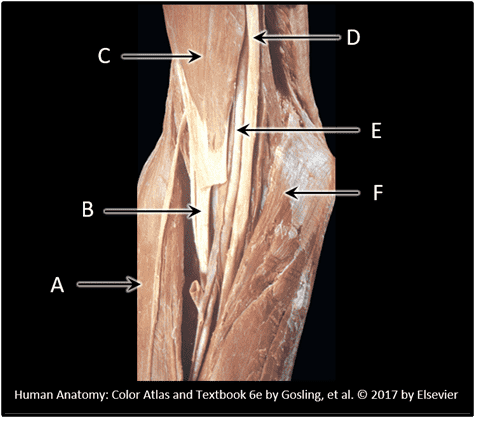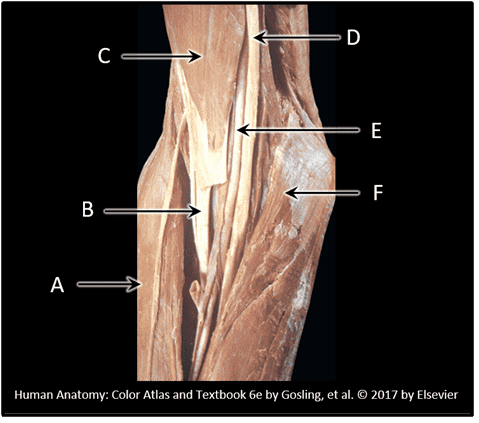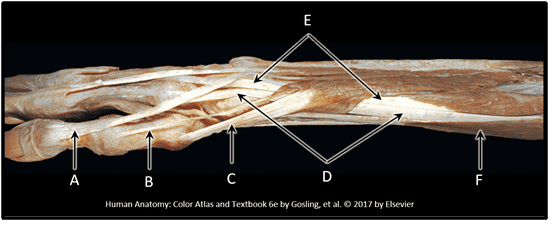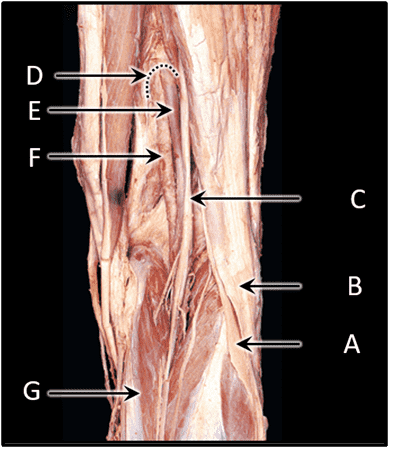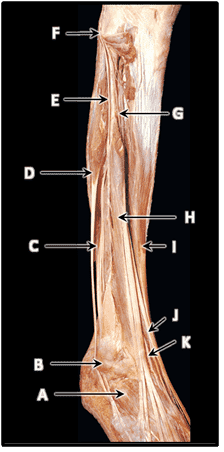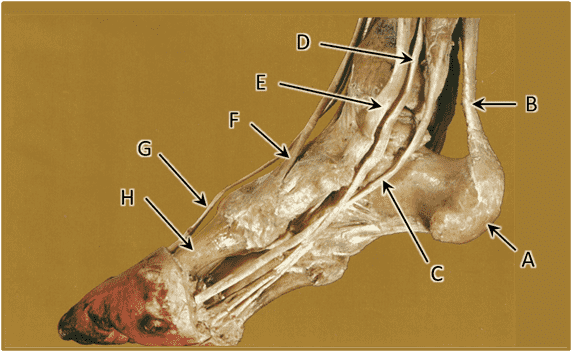Question 1
1) Identify A.
Choices:
- brachioradialis muscle
- biceps brachii tendon
- biceps brachii muscle
- median nerve
- brachial artery
- pronator teres muscle
Answers:
- brachioradialis muscle
Comments:
- Correct
- That's right! The brachioradialis muscle (A) forms the lateral border of the cubital fossa.
- Continue
Question 2
2) Identify B.
Choices:
- brachioradialis muscle
- biceps brachii tendon
- biceps brachii muscle
- median nerve
- brachial artery
- pronator teres muscle
Answers:
- biceps brachii tendon
Comments:
- Correct
- That's right! The biceps brachii tendon(B) is located in the cubital fossa lateral to the brachial artery and median nerve.
- Continue
Question 3
3) Identify C.
Choices:
- brachioradialis muscle
- biceps brachii tendon
- biceps brachii muscle
- median nerve
- brachial artery
- pronator teres muscle
Answers:
- biceps brachii muscle
Comments:
- Correct
- That's right! Since (B) is the biceps brachii tendon, the muscle of the tendon must be biceps brachii muscle (C)!
- Continue
Question 4
4) Identify D.
Choices:
- brachioradialis muscle
- biceps brachii tendon
- biceps brachii muscle
- median nerve
- brachial artery
- pronator teres muscle
Answers:
- median nerve
Comments:
- Correct
- That's right! The median nerve (D) is located on the medial aspect of the cubital fossa. Remember the order of structures in the cubital fossa: TAN!
- Continue
Question 5
5) Identify E.
Choices:
- brachioradialis muscle
- biceps brachii tendon
- biceps brachii muscle
- median nerve
- brachial artery
- pronator teres muscle
Answers:
- brachial artery
Comments:
- Correct
- That's right! The brachial artery (E) is located between the biceps brachii tendon (B) and the median nerve (D).
- Continue
Question 6
6) Identify F.
Choices:
- brachioradialis muscle
- biceps brachii tendon
- biceps brachii muscle
- median nerve
- brachial artery
- pronator teres muscle
Answers:
- pronator teres muscle
Comments:
- Correct
- That's right! The pronator teres muscle (F) forms the medial border of the cubital fossa. The muscle originates from the CFO (common flexor origin).
- Continue
Question 7
7) Identify C.
Choices:
- first lumbrical
- ulnar nerve
- median nerve
- radial artery
- brachioradialis
- flexor carpi radialis
- flexor carpi ulnaris
- flexor digitorum superficialis
Answers:
- median nerve
Comments:
- Correct
- That's right! The median nerve (C) is located medial to the flexor carpi radialis tendon. The median nerve passes through the carpal tunnel to innervate the hand.
- Continue
Question 8
8) Identify D.
Choices:
- first lumbrical
- ulnar nerve
- median nerve
- radial artery
- brachioradialis
- flexor carpi radialis
- flexor carpi ulnaris
- flexor digitorum superficialis
Answers:
- radial artery
Comments:
- Correct
- That's right! The radial artery (D) is located lateral to the tendon of flexor carpi radialis.
- Continue
Question 9
9) Identify E.
Choices:
- first lumbrical
- ulnar nerve
- median nerve
- radial artery
- brachioradialis
- flexor carpi radialis
- flexor carpi ulnaris
- flexor digitorum superficialis
Answers:
- brachioradialis
Comments:
- Correct
- That's right! The brachioradialis (E) is the most lateral muscle. Although it is not shown here, brachioradialis originates proximal to the elbow joint.
- Continue
Question 10
10) Identify F.
Choices:
- first lumbrical
- ulnar nerve
- median nerve
- radial artery
- brachioradialis
- flexor carpi radialis
- flexor carpi ulnaris
- flexor digitorum superficialis
Answers:
- flexor carpi radialis
Comments:
- Correct
- That's right! Flexor carpi radialis is labelled ‘F’. This muscle arises from the CFO together with pronator teres, palmaris longus and flexor carpi ulnaris.
- Continue
Question 11
11) Identify G.
Choices:
- first lumbrical
- ulnar nerve
- median nerve
- radial artery
- brachioradialis
- flexor carpi radialis
- flexor carpi ulnaris
- flexor digitorum superficialis
Answers:
- flexor carpi ulnaris
Comments:
- Correct
- That's right! Flexor carpi ulnaris (G) is located on the anteromedial aspect of the forearm. Similar to other muscles of the superficial layer, it flexes the wrist.
- Continue
Question 12
12) Identify H.
Choices:
- first lumbrical
- ulnar nerve
- median nerve
- radial artery
- brachioradialis
- flexor carpi radialis
- flexor carpi ulnaris
- flexor digitorum superficialis
Answers:
- flexor digitorum superficialis
Comments:
- Correct
- That's right! The flexor digitorum superficialis (H) is in the middle layer of the anterior compartment of the arm. Since palmaris longus is absent in this image, the muscle is visible!
- Continue
Question 13
13) Identify I.
Choices:
- first lumbrical
- ulnar nerve
- median nerve
- radial artery
- brachioradialis
- flexor carpi radialis
- flexor carpi ulnaris
- flexor digitorum superficialis
Answers:
- ulnar nerve
Comments:
- Correct
- That's right! The ulnar nerve (I) enters the hand by crossing superificial to the carpal tunnel. It is therefore not implicated in carpal tunnel syndrome.
- Continue
Question 14
14) Identify A.
Choices:
- extensor pollicis longus
- extensor pollicis brevis
- abductor pollicis longus
- extensor carpi radialis longus
- extensor carpi radialis brevis
- brachioradialis
Answers:
- extensor pollicis longus
Comments:
- Correct
- That's right! The extensor pollicis longus (A) tendon attaches to the second phalange of the thumb, therefore this muscle extends both the MCP and IP joints of the thumb. It also contributes to formation of the posterior border of the anatomical snuffbox.
- Continue
Question 15
15) Identify B.
Choices:
- extensor pollicis longus
- extensor pollicis brevis
- abductor pollicis longus
- extensor carpi radialis longus
- extensor carpi radialis brevis
- brachioradialis
Answers:
- extensor pollicis brevis
Comments:
- Correct
- That's right! Extensor pollicis brevis (B) attaches to the first phalange, and therefore extends the MCP joint
- Continue
Question 16
16) Identify C.
Choices:
- extensor pollicis longus
- extensor pollicis brevis
- abductor pollicis longus
- extensor carpi radialis longus
- extensor carpi radialis brevis
- brachioradialis
Answers:
- abductor pollicis longus
Comments:
- Correct
- That's right! The abductor pollicis longus (C) attaches to the base of the first metacarpal bone and thereby causes abduction of thumb upon contraction.
- Continue
Question 17
17) Identify D.
Choices:
- extensor pollicis longus
- extensor pollicis brevis
- abductor pollicis longus
- extensor carpi radialis longus
- extensor carpi radialis brevis
- brachioradialis
Answers:
- extensor carpi radialis longus
Comments:
- Correct
- That's right! Extensor carpi radialis longus (D) is adjacent to brachioradialis and is on the most lateral aspect of the posterior forearm.
- Continue
Question 18
18) Identify E.
Choices:
- extensor pollicis longus
- extensor pollicis brevis
- abductor pollicis
- extensor carpi radialis longus
- extensor carpi radialis brevis
- brachioradialis
Answers:
- extensor carpi radialis brevis
Comments:
- Correct
- That's right! Extensor carpi radialis brevis (E) is medial to the extensor carpi radialis longus.
- Continue
Question 19
19) Identify F.
Choices:
- extensor pollicis longus
- extensor pollicis brevis
- abductor pollicis
- extensor carpi radialis longus
- extensor carpi radialis brevis
- brachioradialis
Answers:
- brachioradialis
Comments:
- Correct
- That's right! Although brachioradialis (F) is located on the anterolateral aspect of the forearm, it is still considered a muscle of the posterior compartment.
- Continue


